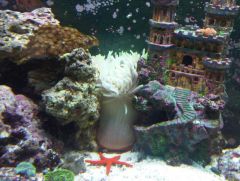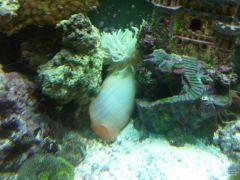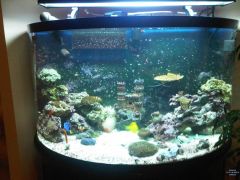
bluce
BB Participant-
Posts
253 -
Joined
-
Last visited
Content Type
Profiles
Forums
Gallery
Events
Store
Everything posted by bluce
-
This contributer to WetWeb Media believes phyto has its uses http://www.wetwebmedia.com/phytoplankton.htm See article below I guess my opinion is that it is good with lite dosing. Phytoplankton: Use in Marine Aquariums by Sara Mavinkurve Help , gear is definitely available What is phytoplankton? "Phytoplankton" is a term that covers a broad group of autotrophic micro-organisms. Though not usually included in the aquarist's concept of phytoplankton, diatoms and dinoflagellates are also types of phytoplankton. The types of phytoplankton commonly used in aquarium feeding products are Chaetoceros, Nannochloropsis, Tetraselmis and Isocrysis species (among others). These are commonly used in aquarium feeding likely because they are easy to culture and thought to be of the approximate size best for the organisms we want to feed with them. 3 Sources of Phytoplankton (for aquarists): 1) Phytoplankton in Your Tank: Some phytoplankton is actually already in your system. In fact, when you wipe your glass clean with a sponge or Magfloat, and you see green clouds of green or brown released from the glass--that's phytoplankton (along with bacteria films, pods and other coral/invert yummies). 2) Culturing Phytoplankton at Home: Phytoplankton can also be cultured at home. In my opinion, unless you need a very "pure" (containing only one particular species of phytoplankton) culture, culturing at home is not quite as difficult or cumbersome as it's rumored to be. I've done so on a windowsill in a simple 2.5 gallon tank with an airstone. I simply used DT's to start (which is a mix of phytoplankton species). The resulting culture was likely only one of these species (when a mix is used to start a culture, one will almost always out compete the others). My culture was also likely populated with bacterias and other microbes. But for my purposes, this was just fine (if not a good thing). All you really need to culture your own phytoplankton is a dedicated tank (or other water holding container), airstone, light source, and "food"/fertilizer for the algae. (Note: For more step-by-step instructions: Melev's article on phytoplankton culture) 3) Store Bought Phytoplankton: There are many different types and brands of phytoplankton products sold online and aquarium stores. They differ in concentration, mix of species and the form in which they are stored/distributed (i.e. frozen, refrigerated, spray-dried, etc). Phytoplankton won't survive in the freezer, nor will it survive at room temperature. Most will not survive under refrigeration. However, there are a few species that will. The freezer is too cold. At room temperature, the algae would need light and air to survive. However, in the refrigerator, a few species of phytoplankton can go into a kind of "dormant" state, which allows them to survive with little air or light. "Live" Refrigerated Phytoplankton ControversyWhen it comes to refrigerated phytoplankton products, not all are created equal. This subject is highly "controversial" in the reef aquarium hobby. Regardless, I'll dare to say that, based on my knowledge/experience, I don't believe that all are quite as entirely live as they claim to be. That's not to say that all the cells are dead. These products might all have some live cells. It's simply that some contain species that are not of those known to survive under refrigeration. I believe that, of the refrigerated phytoplankton products sold as "live," DT's phytoplankton (when properly kept and stored) is likely the highest quality (most live cells). Personally, it's the only one from which I'd try to start my own culture. That said, the other refrigerated products, which likely contain fewer live cells, are not bad and can certainly be used for many of the same applications. In fact, for some applications, they might be better. As with most aquarium products, ultimately, it's best to judge for yourself (try different products and see what works best in your system). Frozen and spray-dried phytoplankton products are certainly dead phytoplankton cells. Again, that doesn't mean they are useless. For spray-dried phytoplankton, you'll want to soak the dry phytoplankton first. If you don't, it will float (and likely get sucked down an overflow). While live phytoplankton is generally better and will feed more organisms more effectively, frozen and spray-dried phytoplankton still has its uses. Chances are, at least some critters in the aquarium will eat it. It can also be used to feed/raise brine shrimp, rotifers, etc. Reasons to feed phytoplankton: There are a few aquarium corals which feed on phytoplankton. The most common ones are Dendronephtya and ahermatypic (lacking zooxanthelle) Gorgonians. It's quite possible/likely that other ahermatypic, azooxanthelle corals also feed on phytoplankton, but the Dendronephtya and ahermatypic (lacking zooxanthelle) Gorgonians absolutely need phytoplankton. Most the corals we keep in aquariums are Hermatypic (both autotrophic and heterotrophic). This is a fancy way of saying that they both eat food and use light for photosynthesis. For the most part, these corals don't feed on phytoplankton (or, if they do, not primarily). However, phytoplankton can feed these corals indirectly by feeding the "critters" in our systems. These critters, when well fed, can continually reproduce, providing a great source of "natural" food for hermatypic corals. Feeding corals in this way is beneficial also because it provides a more constant (vs. intermittent) food supply (which is closer to how corals feed in the wild). [Note: In most cases, it's best not to try to target feed your corals phytoplankton... especially if the phytoplankton is cold, concentrated store-bought product. The best way to feed phytoplankton is to either drip it in continuously or pour it into a high current area of your tank.] Another argument for phytoplankton feeding is that phytoplankton feeds benthic and refugium/sump critters that help process waste. Keeping healthy populations of these organisms can help keep your tank "clean" and healthy all around. Phytoplankton is also used in the culturing of zooplankton used to feed, among other things, fish larvae. [Note: For some further reading on this use of phytoplankton: The Breeder's Net by Frank Marini] Arguments against phytoplankton feeding: If unconsumed, the phytoplankton will degrade and just become another source of nitrogenous waste. This might be a concern in small systems without refugiums
-
LOL - your "old" tank looks better than most peoples current tanks! I'm sure you do many things different today, but your video doesn't really demonstrate your point about how things have advanced since your old tank looked so nice.
-
We can even make this more complicated for you due to the time value of money. The present value of the money spent for the LED lighting fixture is worth more than the future cost savings. Example say your new fixture costs $2000 and you figured that your going to save $300 / year in electricty + an additional $100 for bulb replacement. Initially you would think that you would recoup your investment in 2000 / 400 = 5 years. The problem is that your $2000 (due to time value) isn't worth as much in 5 years as it is today. So the Future value (FV) of the initial $2000 invested 5 years from now is P * (1+i) nth Where P is the present value, i = interest rate (lets say 5%) and n = the number of years. 2000 * (1+.05) 5th power = $2552. Actually it would be less because your not paying out everything on the 5th year. So in this example it would take more time to actually recoup the true value of your present day investment
-
I have a pistol shrimp i have seen once - I know it's still alive, cause I still here him shooting! I do see my coral banded shrimp all the time - she has gotten huge since we aquired her.
-
Hey Everyone! I might be back.
bluce replied to Kimchi Corals's topic in Welcome to WAMAS: FAQ / FYI / Hobby News
Welcome back - wasn't here when you were here, but always nice to see people come back home for Afghanistan. -
I just checked the calendar - FYI I didn't see the oct meeting listed there.
-
Very nice - thanks for the info. Do you think it's worth it to pay the extra to get 1 male and 2 females?
-
Damsels are usually pretty hardy - do you have other fish that could be being aggressive towards it? Not sure about the black and white ones - I had some clowns that didn't like my yellow tail damsel and they harrassed it too much. If you have lots of hermit crabs you probably won't find it if it dies, but if you do, definitely take it out.
-
Now I just need to wait for a good group buy opportunity!
-
Thanks for everyones suggestions and advice. Me and my wife have decided to go for 3 Bartletts - we may also add 2 orange line Chromis's later. So reefer got any good advice on keeping these guys healthy? I know you need around 3 feedings a day, but what do you feed them? Any other good husbandry tips on these guys would be appreciated.
-
I'm doing the homework So to avoid the headaches i will rule out the Leopard Wrasse's. Still thinking about the Bartlett's Anthias (getting 3 if I do that). I'm liking Trock's idea - maybe get 3 green chromis and 2 blue reef chromis - the contrast may look very nice. I didn't know they would mix together. Now I'm also considering 3 Vanderbuilt Chromis's http://www.liveaquar...721&pcatid=1721 Unfortunately they are more expensive. Anyone have anythoughts on these guys? I also found the Black and White, and the Orange line chromis's - does anyone know if those will mix with each other, or the green reef chromis? I guess it seems that most of the shoaling options for an aquarium that doesn't require expert care level seem to fall into the Chromis camp. More suggestions are appreciated as I'm still researching. Thanks to all for the information / opinions so far.
-
Ho do you determine how many GPH flow you need for your system?
bluce replied to Jan's topic in General Discussion
You can take a rough measurement by timing how fast you fill up a 1 gallon container when the return pump is turned on. -
Ho do you determine how many GPH flow you need for your system?
bluce replied to Jan's topic in General Discussion
Below are 2 good articles on Flow rate or water turnover - enjoy! http://saltaquarium.about.com/cs/beginnerscorner/a/aa081399.htm http://www.aquariumpros.com/articles/howtopump.shtml -
Im leaning towards Anthias or the Leopard wrasses - I didn't think Bartletts got too big. I want an interesting / active fish with a little more color than the Chromis.
-
Nice suggestion - I looked them up, they are nice looking fish - and it indicated that adding 3 together would be fine. I will definitely add them to the short list.
-
Doesn't sound that bad to me - are you assuming that because the old growth on the live rock has has died, that your water isn't cycling? I wouldn't think that is the case. It sounds like your water is cycling ok. In fact it sounds like you have more or even too much bacteria in there. Your nitrates are low, and your ammonia is close to 0 even after you added pure ammonia. Something broke that down. It might be time to add 1 fish - right now you have nothing adding any natural ammonia to be broken down. The live rock takes weeks, months, or longer to get new growth on it. You can try dosing once a week with "purple up" that has helped my lr. Cheers - and be patient.
-
So I am planning on adding some more fish to my 76 gallon aquarium. Right now I only have 1 yellow tank, 1 algae blenny, and 1 watchman goby. I wanted to add 3 to 5 shoaling / schooling fish, as I think when you see fish swimming as a group in an aquarium it adds a nice dimension. The only types I could think of would be: Green Chromis - maybe 5 Bartletts Anthias - maybe 3 I need a few more ideas - if anyone has experience with these or other shoaling fish that are reef safe, let me know. Attach pics if you have any.
-
Hello all - looking for some creative ideas. I have an oceanic 76 gallon half circle tank. I have a cpr overflow with 2 drains to the sump - whic is around 6 to 8 gallons. I have both drains emptying into the first compartment of the sump where there is mechanical filtration plus carbon. The tank is in the living room and I try to reduce noise while keeping a good environment for the fish and corals. My return pump was an older rio 2500+ which seemed to pump enough water, but was making too much of vibration and humming noise. I recently upgraded to a mag9.5 pump which is not very noisy in itself, but the waterflow sound down to the sump has really increased, so a lot more water sounds. Inside the DT it appears this pump might be putting out too much - I have it coming out of 1 return hose. I guess some better plumbing inside the tank would disperse the water better, but the sump noise would be the same. First is a mag 9.5 (900 gallons an hour) too much flow for a 76 gallon tank? Second is how to quiet the water rushing noise into the sump? Ill take a few pics to show the setup
-
Thanks for the link - this is what I thought it would be too. I just don't like to dismiss things without any consideration. It was nice to see the product deconstructed and shown to be a scam.
-
I was wondering if anyone heard of "Eco Aqualizer" and what is the forums thoughts on this http://www.ecoaqualizer.com/aquarium_filter/technology.php Is this something to think about, or a scam?
-
What kind of clam? If you have a pic, please post.
-
I have the exact same one - works great. I just wish it was as quiet as a true whisper model. I have mine in my living room, so i always strive to get components that are completely silent. I can still hear / feel the vibration the motor makes. While were on the topic - anyone have good suggestions to deaden the vibration on these type of air pumps?




